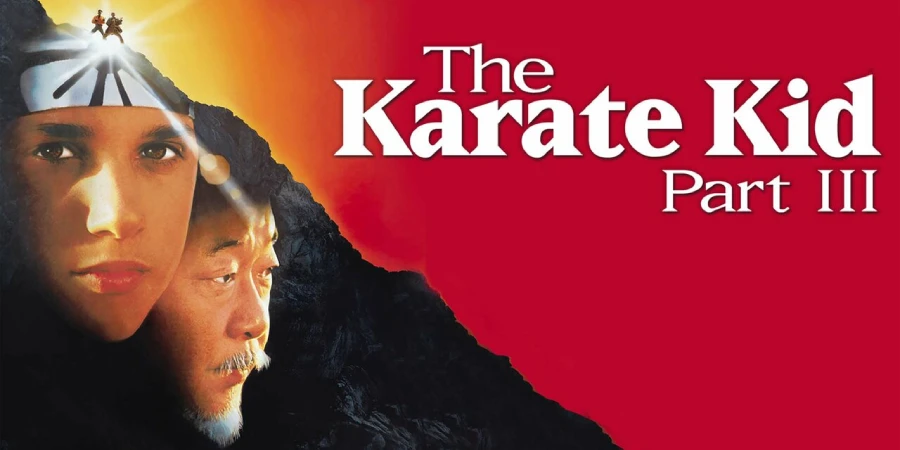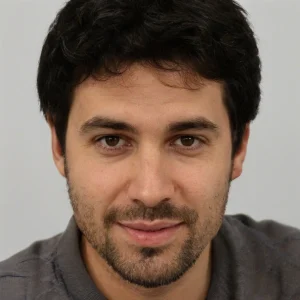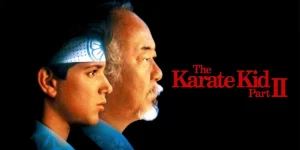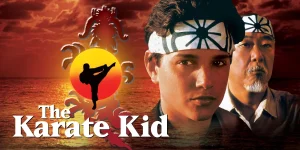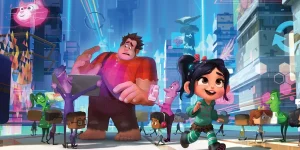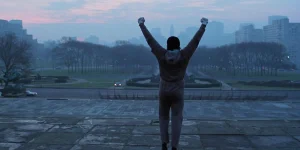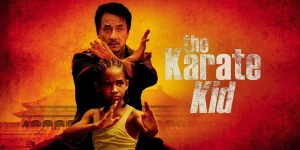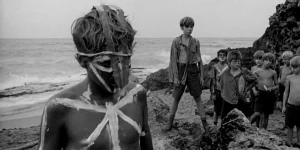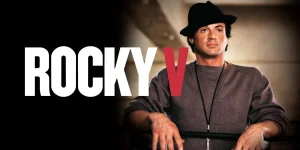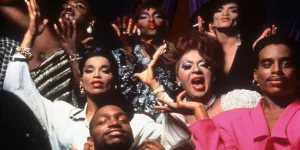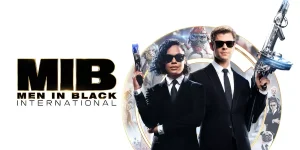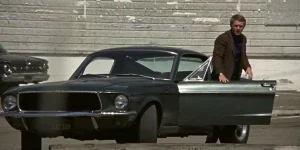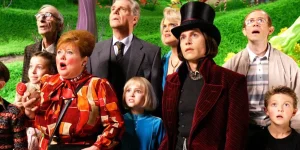The Karate Kid Part III, directed by John G. Avildsen, continues the journey of Daniel LaRusso and his wise mentor Mr. Miyagi as they face new threats—both physical and emotional. Released in 1989, the film marks a darker chapter in the franchise, bringing back old enemies and introducing one of the most sadistic villains in the series.
Table of Contents
ToggleDetailed Summary
Returning Home – A New Challenge
The film picks up almost immediately after the events of The Karate Kid Part II. Upon returning to Los Angeles from their trip to Okinawa, Daniel (Ralph Macchio) learns that his mother is away caring for a sick uncle in New Jersey. Meanwhile, Mr. Miyagi (Pat Morita) faces the demolition of his apartment complex. Wanting to help, Daniel decides to use his college fund to support Miyagi in starting a bonsai shop—despite Miyagi’s hesitation about mixing business with friendship.
Enter Terry Silver – The Puppet Master
Meanwhile, John Kreese (Martin Kove), the disgraced Cobra Kai sensei, is reeling from his humiliation at the hands of Daniel and Miyagi. His rich, sadistic friend Terry Silver (Thomas Ian Griffith), a corrupt businessman and Vietnam war buddy, offers to exact revenge by manipulating Daniel. Silver poses as a sympathetic figure and slowly begins to turn Daniel against Miyagi, feeding his ego and training him in an aggressive, Cobra Kai-style of karate.
The Rise of Mike Barnes
Silver also hires Mike Barnes (Sean Kanan), a vicious young fighter dubbed “Karate’s Bad Boy,” to pressure Daniel into defending his All-Valley title. Alongside goons Snake and Dennis, Barnes uses intimidation tactics to force Daniel into signing up for the tournament, which he initially refuses.
Daniel’s Inner Struggles
Throughout the movie, Daniel becomes increasingly angry and aggressive due to Silver’s manipulation and training. Miyagi senses this and refuses to train Daniel for the tournament, believing karate is only for defense, not trophies. Daniel becomes isolated, loses control during a sparring match, and ultimately realizes he’s being used.
The Truth Comes Out
The turning point occurs when Daniel discovers that Silver, Kreese, and Barnes are working together. The revelation shatters him emotionally, and he returns to Miyagi—broken and ashamed. Miyagi forgives him and agrees to train him the right way once again.
Movie Ending
The climactic battle takes place at the All-Valley Karate Tournament, where Daniel defends his title despite only signing up at the last moment. The format has changed—this time, he only needs to fight one match, the final, against Mike Barnes. The match is brutal, as Barnes tries to injure Daniel repeatedly under Silver’s instructions.
With Miyagi’s support, Daniel regains his confidence and composure. Despite multiple fouls from Barnes and heavy physical punishment, Daniel uses the kata (a choreographed form) that Miyagi taught him to confuse Barnes. With one swift, clean technique, Daniel defeats him and retains his title.
The crowd erupts in applause, Kreese and Silver are humiliated once more, and Daniel learns a valuable lesson about pride, trust, and the true purpose of karate. Miyagi smiles proudly, marking the emotional end of their arc in the trilogy.
Are There Post-Credits Scenes?
No, The Karate Kid Part III does not feature any post-credits scenes. The film ends traditionally, with the victory and celebration wrapping up before the credits roll.
Type of Movie
This is a sports drama/martial arts film with themes of mentorship, personal growth, and overcoming manipulation. It’s a character-driven story wrapped in a coming-of-age framework, leaning into darker emotional territory than its predecessors.
Cast
- Ralph Macchio as Daniel LaRusso
- Pat Morita as Mr. Miyagi
- Thomas Ian Griffith as Terry Silver
- Martin Kove as John Kreese
- Sean Kanan as Mike Barnes
- Robyn Lively as Jessica Andrews
Film Music and Composer
The score was composed by Bill Conti, who also scored the previous Karate Kid films (and the Rocky series). His music continues to blend East Asian instrumentation with classic orchestral motifs, underscoring Daniel’s emotional and martial journey.
The soundtrack includes songs like “The Moment of Truth” by Survivor and other late-80s rock tracks that reflect the more intense, darker mood of this third installment.
Filming Locations
- Los Angeles, California: Main filming location, including scenes at Mr. Miyagi’s house and the All-Valley Tournament.
- Franklin Canyon Park: Used for outdoor training and bonsai tree scenes.
- Stage sets: Silver’s dojo and various interiors were constructed on soundstages.
These locations emphasize the contrast between the peaceful, serene philosophy of Miyagi and the commercial, aggressive world of Cobra Kai.
Awards and Nominations
The Karate Kid Part III didn’t receive any major awards or critical acclaim. In fact, it received several Razzie Award nominations, including:
- Worst Supporting Actor (Pat Morita)
- Worst Actor (Ralph Macchio)
- Worst Picture
Despite these, the movie gained cult status among fans and contributed to the enduring legacy of the franchise.
Behind the Scenes Insights
- Thomas Ian Griffith made his film debut as Terry Silver; he was only three years older than Ralph Macchio despite playing a much older man.
- Ralph Macchio was 27 playing a teenager again.
- Sean Kanan suffered a serious internal injury during filming, which nearly killed him, but he returned to finish the movie.
- Pat Morita reportedly disliked the script and the film’s darker tone.
- Many scenes had to be rewritten due to Macchio’s refusal to perform certain fight stunts.
Inspirations and References
While not based on a specific book, the Karate Kid series draws heavily from Eastern philosophy—particularly Okinawan martial arts and Zen teachings. The conflict between Cobra Kai’s aggression and Miyagi’s peaceful philosophy mirrors traditional martial arts ideologies.
The film also reflects 1980s fears of corporate greed, with Terry Silver serving as a caricature of unchecked wealth and corruption.
Alternate Endings and Deleted Scenes
There are no major alternate endings officially released, but several deleted scenes have surfaced:
- More development of Jessica and Daniel’s friendship.
- A scene showing Silver bribing the tournament organizers.
- A longer training montage of Daniel practicing with Cobra Kai methods.
These scenes were cut to tighten the pacing and reduce the runtime.
Book Adaptations and Differences
There were novelizations of the film released alongside the movie, but they generally follow the same plot. The main difference is that the book delves more into Daniel’s inner conflict, providing more emotional nuance than the film’s dialogue-heavy format.
Memorable Scenes and Quotes
Key Scenes
- Daniel practicing bonsai on a cliffside.
- Terry Silver’s evil laugh while bathing in a tub and planning revenge.
- Daniel breaking down after injuring his knuckles on a wooden dummy.
- Mr. Miyagi fighting Kreese and Silver without throwing a punch.
Iconic Quotes
- Mr. Miyagi: “For man with no forgiveness in heart, life worse punishment than death.”
- Terry Silver: “I love it when he begs.”
- Daniel: “You’re the best friend I’ve ever had.”
- Miyagi: “Karate for defense only.”
Easter Eggs and Hidden Details
- Terry Silver mentions dumping toxic waste—foreshadowing his corporate villainy shown again in Cobra Kai.
- The Cobra Kai dojo is still decorated with the same banners and images from the original film.
- Daniel’s kata in the final match is the same style he learned in Okinawa in Part II.
Trivia
- Ralph Macchio has admitted this is his least favorite Karate Kid film.
- Pat Morita’s Oscar nomination from the first film didn’t shield him from Razzie nominations here.
- Thomas Ian Griffith practiced martial arts in real life and performed many of his own stunts.
- The film was released five years after the first Karate Kid, leading to continuity challenges.
Why Watch?
Watch this film if you’re a fan of redemption arcs, darker themes, and martial arts showdowns. It’s also essential viewing for fans of the Cobra Kai series, which draws heavily from this chapter—especially with the return of Terry Silver and Mike Barnes decades later.
Director’s Other Movies
Recommended Films for Fans
- The Karate Kid (1984)
- The Karate Kid Part II (1986)
- The Next Karate Kid (1994)
- Rocky III (1982)
- Best of the Best (1989)
- Sidekicks (1992)

